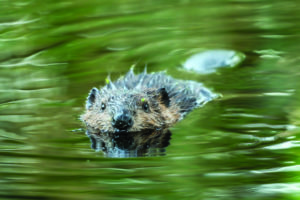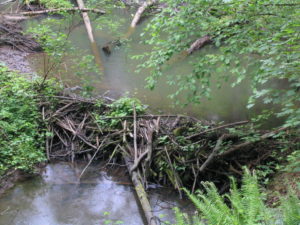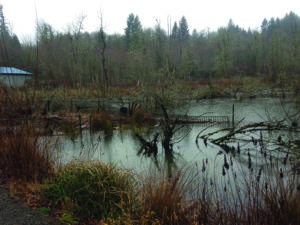Beavers Build Resilient Watersheds
The Wishpush Working Group envisions an abundant beaver population

Photo by Jen Vanderhoof / Beavers Northwest
Beaver (Castor canadensis) is a keystone species across North America. “Beavers are ecosystem engineers,” explains Jeanette Burkhardt, a watershed planner with Yakama Nation Fisheries who has been interested in how beavers benefit watersheds for several years. “Through their daily activities, they alter the landscape and create habitat for other species including fish (they benefit all life stages of salmonids), aquatic animals, and birds. They are also important prey for carnivores,” she said.
“I have seen beavers take up residence and alter really varied landscapes, from desert creeks to powerful rivers,” shared Burkhardt. “They never cease to amaze me with their adaptability and industriousness. I remember I once visited a riparian restoration project Yakama Nation Fisheries had recently completed, and the beavers had moved right in and already begun chewing vegetation and excavating foraging channels. That felt like a real seal of approval!”
Burkhardt is also a leader of the Wishpush Working Group which is working to retain, restore, and rehome beavers in the Yakama Nation’s Southern Territories which include the Wind, White Salmon, Klickitat, and Rock Creek watersheds. The group envisions abundant beaver populations creating healthier and more resilient watersheds for the benefit of fish, wildlife, and humans.
The name of the working group, wishpush (or wishpoosh), comes from the word for beaver in Yakama creation stories. “Columbia River Tribes believe that animals took care of these lands long before humans lived here,” explained Elaine Harvey, Hydro Systems Oversight Coordinator with Yakama Nation Fisheries and Columbia Land Trust board member. “The beaver is a caretaker, responsible for the water and animals that live in rivers. They regulate water flow throughout the year which benefits the entire landscape.”
As climate change leads to increased frequency and strength of wildfires, the work of beavers can have significant beneficial impacts. Wet beaver meadows can function as fire breaks and shield plants and animals from high-intensity burning, and beaver dams have been shown to reduce the power of runoff and filter out sediment that fills rivers and streams after a wildfire.
The Wishpush Working Group originated in 2018 as a collective of natural resource managers that came together to examine beaver populations in the East Cascades and plan strategies to retain and grow beaver populations for the many ecological benefits they provide. While the group has grown into a broader coalition, the core steering committee remains Mount Adams Resource Stewards, Yakama Nation Fisheries, and the Mid-Columbia Fisheries Enhancement Group.
Columbia Land Trust is drawing on modeling work and technical support offered by the working group to inform stewardship plans for more than 8,000 acres of recently conserved habitat on the upper Klickitat River. “Beaver activity has been documented as a factor in moderating fire intensity and creating a refuge for wildlife during wildfires,” says Land Trust Natural Area Manager Lindsay Cornelius. “We are going to be using a beaver restoration assessment tool at our Bear Creek Natural Area, where we’re also planning to collaborate with the Yakama Nation and Washington Department of Natural Resources on prescribed fire and fuel reduction treatments. I’m excited to explore the potential of incorporating beaver reintroduction into our restoration plans.”
 Adept swimmers but awkward on land, beavers build dams and foraging channels to create deep water where they can navigate easily, access food sources, and avoid predation. This backed up water then spreads across the surrounding landscape, creating complex side channels that support fish habitat and seeping into the ground, refilling underground aquifers. Beaver complexes can also act as water filters, trapping sediment and filtering out toxins to improve downstream water quality, in addition to slowing spring runoff, which buffers the impact of flooding and drought.
Adept swimmers but awkward on land, beavers build dams and foraging channels to create deep water where they can navigate easily, access food sources, and avoid predation. This backed up water then spreads across the surrounding landscape, creating complex side channels that support fish habitat and seeping into the ground, refilling underground aquifers. Beaver complexes can also act as water filters, trapping sediment and filtering out toxins to improve downstream water quality, in addition to slowing spring runoff, which buffers the impact of flooding and drought.
“In arid environments with dry summers like the East Cascades, it is important to have sources of water that contribute to streamflow during the warm summer months, especially in the climate scenarios we are seeing where there is less snowpack in the future,” said Burkhardt. “Beaver complexes can act as this type of water source to some degree, like a sponge that soaks up water when it is abundant and slowly releases it later.”
Beaver populations in North America, including Oregon and Washington, were decimated by the colonial fur trade in the 1800’s when Euro-American settlers trapped them nearly to extinction. It is roughly estimated that there used to be as many as 100-200 million beavers in North America. Estimates put the current population around 10-15 million, only one tenth as abundant as they were pre-European settlement. “The removal and continued scarcity of beavers has had a drastic impact on the shape and health of western watersheds,” said Burkhardt.
Beavers continue to face immediate threats. As more humans move into prime beaver habitat, conflict with human infrastructure increases when beavers fell trees and their dams flood roads and block culverts and irrigation ditches. “There is room for improvement in terms of awareness of the benefits that beavers bring to ecosystems,” said Burkhardt. “They should not be considered a pest or a nuisance species. There is a lot of misinformation out there and there is a growing set of tools to mitigate for their impacts on the human environment.” Climate change—and the habitat degradation and fragmentation it brings—is another threat to beaver populations.
Despite these challenges, Burkhardt and the working group are hopeful. There is increasing awareness that beavers are crucial to watershed health, that they improve hydrology, build resilience, and can mitigate the impacts of climate change and wildfire damage. “It’s quite exciting—new working groups focused on beaver conservation are popping up all over the place,” she said. “It’s not new work but there is increasing interest. Some conservation organizations are even using human-made structures that mimic beavers’ work as a fish habitat restoration tool.”

A beaver deceiver in the Washougal River watershed
Though not as functional as authentic beaver dams (which beavers diligently maintain!), these analogs are useful in locations where unpredictable beaver activity may be less tolerated by neighbors or where ponding might interfere with public infrastructure like roads and culverts.
The working group is in the process of building out resources and support services to help landowners coexist with beavers. These tools include things like beaver deceivers and pond levelers; technologies that keep beavers from blocking culverts and other outlets while still allowing water flow, which can allow the beavers to remain while minimizing infrastructure damage. The Wishpush group is also setting up a beaver “hotel”—a temporary holding facility for beavers and beaver families that need relocation—and creating a database of suitable habitat locations where they could potentially re-home beavers, like Columbia Land Trust’s Bear Creek Natural Area.
“I’m excited to continue gathering information from the community,” said Burkhardt, “and there are lots of educational opportunities. Beavers themselves are a hopeful beacon in difficult times, with their ability to restore watersheds, increase biodiversity, and create oases during wildfires.”